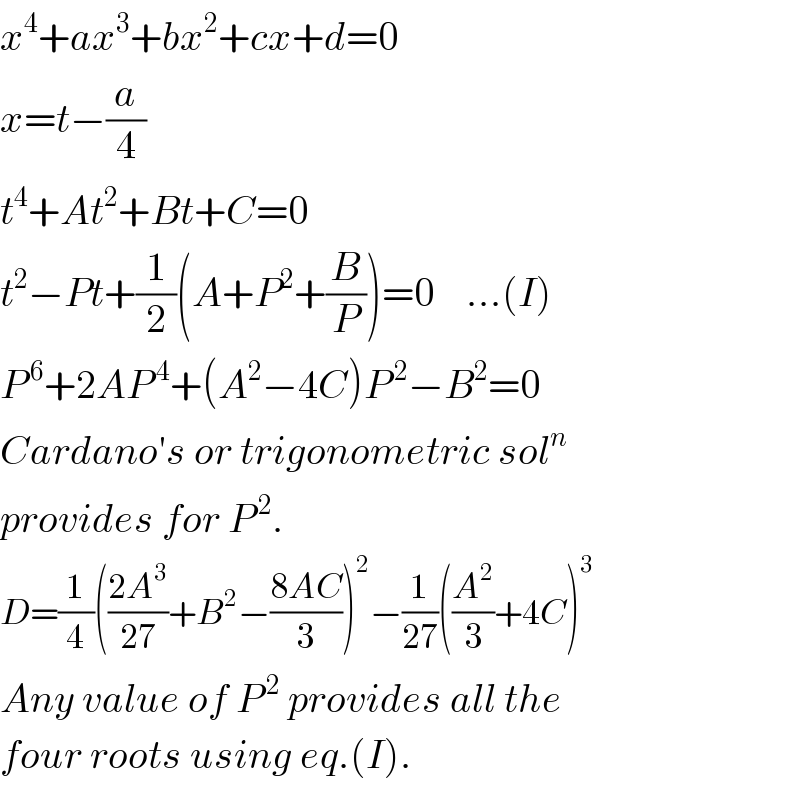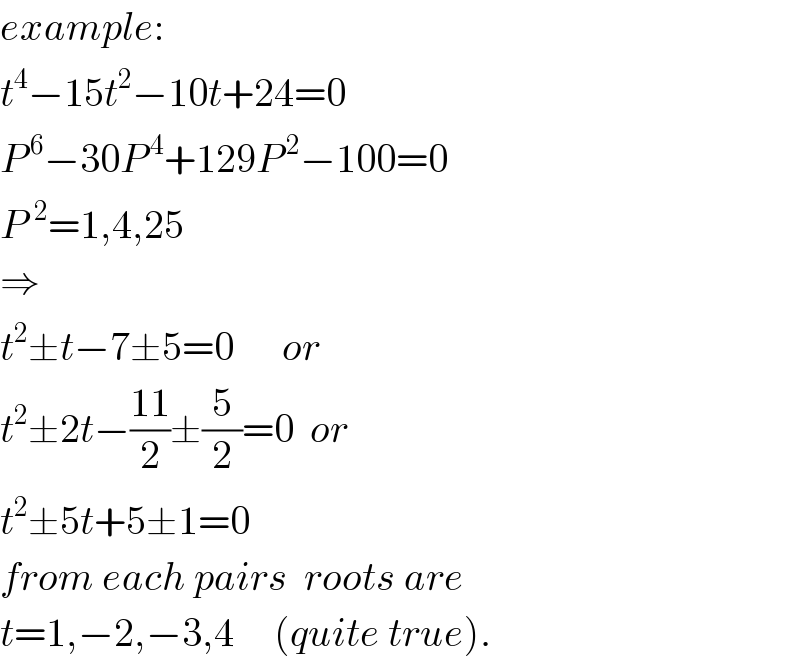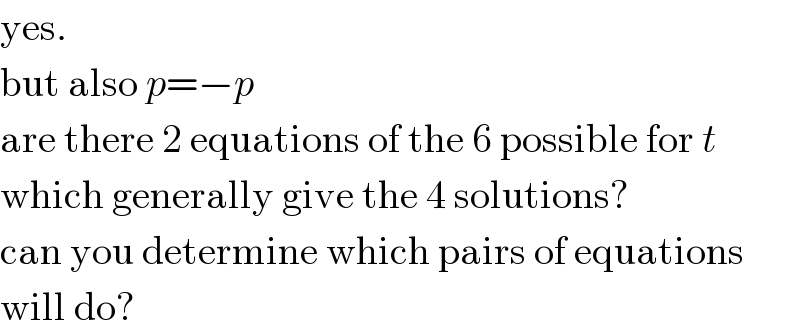
Question Number 65830 by ajfour last updated on 04/Aug/19

Commented by ajfour last updated on 04/Aug/19

$${x}^{\mathrm{4}} +{ax}^{\mathrm{3}} +{bx}^{\mathrm{2}} +{cx}+{d}=\mathrm{0} \\ $$$${let}\:{roots}\:{be}\:−{p},−{q},−{r},−{s}. \\ $$$${Find}\:{p},{q},{r},{s}\:{in}\:{terms}\:{of}\:{a},{b},{c},{d}. \\ $$$${a},{b},{c},{d}\:\in\mathbb{R}. \\ $$
Commented by MJS last updated on 05/Aug/19

$$\mathrm{my}\:\mathrm{method}\:\mathrm{as}\:\mathrm{I}\:\mathrm{did}\:\mathrm{before}\:\mathrm{is}\:\mathrm{putting} \\ $$$$−{p}=\alpha−\sqrt{\beta} \\ $$$$−{q}=\alpha+\sqrt{\beta} \\ $$$$−{r}=\gamma−\sqrt{\delta} \\ $$$$−{s}=\gamma+\sqrt{\delta} \\ $$$$\mathrm{which}\:\mathrm{leads}\:\mathrm{to} \\ $$$$\alpha=−\gamma−\frac{{a}}{\mathrm{2}} \\ $$$$\beta=−\gamma^{\mathrm{2}} −\frac{{a}}{\mathrm{2}}\gamma+\frac{{a}^{\mathrm{2}} −\mathrm{4}{b}}{\mathrm{8}}+\frac{{a}^{\mathrm{3}} −\mathrm{4}{ab}+\mathrm{8}{c}}{\mathrm{8}\left(\mathrm{4}\gamma+{a}\right)} \\ $$$$\delta=−\gamma^{\mathrm{2}} −\frac{{a}}{\mathrm{2}}\gamma+\frac{{a}^{\mathrm{2}} −\mathrm{4}{b}}{\mathrm{8}}−\frac{{a}^{\mathrm{3}} −\mathrm{4}{ab}+\mathrm{8}{c}}{\mathrm{8}\left(\mathrm{4}\gamma+{a}\right)} \\ $$$$\gamma^{\mathrm{6}} +\frac{\mathrm{3}{a}}{\mathrm{2}}\gamma^{\mathrm{5}} +\frac{\mathrm{3}{a}^{\mathrm{2}} +\mathrm{2}{b}}{\mathrm{4}}\gamma^{\mathrm{4}} +\frac{{a}\left({a}^{\mathrm{2}} +\mathrm{4}{b}\right)}{\mathrm{8}}\gamma^{\mathrm{3}} +\frac{\mathrm{2}{a}^{\mathrm{2}} {b}+{ac}+{b}^{\mathrm{2}} −\mathrm{4}{d}}{\mathrm{16}}\gamma^{\mathrm{2}} +\frac{{a}\left({ac}+{b}^{\mathrm{2}} −\mathrm{4}{d}\right)}{\mathrm{32}}\gamma−\frac{{a}^{\mathrm{2}} {d}−{abc}+{c}^{\mathrm{2}} }{\mathrm{64}}=\mathrm{0} \\ $$$$\gamma={r}−\frac{{a}}{\mathrm{4}} \\ $$$${r}^{\mathrm{6}} −\frac{\mathrm{3}{a}^{\mathrm{2}} −\mathrm{8}{b}}{\mathrm{16}}{r}^{\mathrm{4}} +\frac{\mathrm{3}{a}^{\mathrm{4}} −\mathrm{16}{a}^{\mathrm{2}} {b}+\mathrm{16}{ac}+\mathrm{16}\left({b}^{\mathrm{2}} −\mathrm{4}{d}\right)}{\mathrm{256}}{r}^{\mathrm{2}} −\frac{\left({a}^{\mathrm{3}} −\mathrm{4}{ab}+\mathrm{8}{c}\right)^{\mathrm{2}} }{\mathrm{4096}}=\mathrm{0} \\ $$$${r}=\sqrt{{s}} \\ $$$${s}^{\mathrm{3}} −\frac{\mathrm{3}{a}^{\mathrm{2}} −\mathrm{8}{b}}{\mathrm{16}}{s}^{\mathrm{2}} +\frac{\mathrm{3}{a}^{\mathrm{4}} −\mathrm{16}{a}^{\mathrm{2}} {b}+\mathrm{16}{ac}+\mathrm{16}\left({b}^{\mathrm{2}} −\mathrm{4}{d}\right)}{\mathrm{256}}{s}−\frac{\left({a}^{\mathrm{3}} −\mathrm{4}{ab}+\mathrm{8}{c}\right)^{\mathrm{2}} }{\mathrm{4096}}=\mathrm{0} \\ $$$${s}={t}+\frac{\mathrm{3}{a}^{\mathrm{2}} −\mathrm{8}{b}}{\mathrm{48}} \\ $$$${t}^{\mathrm{3}} +\frac{\mathrm{3}{ac}−{b}^{\mathrm{2}} −\mathrm{12}{d}}{\mathrm{48}}{t}−\frac{\mathrm{27}{a}^{\mathrm{2}} {d}−\mathrm{9}{abc}+\mathrm{2}{b}^{\mathrm{3}} −\mathrm{72}{bd}+\mathrm{27}{c}^{\mathrm{2}} }{\mathrm{1728}}=\mathrm{0} \\ $$$$\mathrm{and}\:\mathrm{we}\:\mathrm{can}\:\mathrm{always}\:\mathrm{solve}\:\mathrm{this} \\ $$$$\mathrm{depending}\:\mathrm{on}\:{D}\:\mathrm{we}\:\mathrm{need}\:\mathrm{Cardano}'\mathrm{s}\:\mathrm{or}\:\mathrm{the} \\ $$$$\mathrm{trigonometric}\:\mathrm{method} \\ $$$${D}=\mathrm{27}{a}^{\mathrm{4}} {d}^{\mathrm{2}} −\mathrm{18}{a}^{\mathrm{3}} {bcd}+\mathrm{4}{a}^{\mathrm{3}} {c}^{\mathrm{3}} +\mathrm{4}{a}^{\mathrm{2}} {b}^{\mathrm{3}} {d}−{a}^{\mathrm{2}} {b}^{\mathrm{2}} {c}^{\mathrm{2}} −\mathrm{144}{a}^{\mathrm{2}} {bd}^{\mathrm{2}} +\mathrm{6}{a}^{\mathrm{2}} {c}^{\mathrm{2}} {d}+\mathrm{80}{ab}^{\mathrm{2}} {cd}−\mathrm{18}{abc}^{\mathrm{3}} +\mathrm{192}{acd}^{\mathrm{2}} −\mathrm{16}{b}^{\mathrm{4}} {d}+\mathrm{4}{b}^{\mathrm{3}} {c}^{\mathrm{2}} +\mathrm{128}{b}^{\mathrm{2}} {d}^{\mathrm{2}} −\mathrm{144}{bc}^{\mathrm{2}} {d}+\mathrm{27}{c}^{\mathrm{4}} −\mathrm{256}{d}^{\mathrm{3}} \\ $$
Commented by ajfour last updated on 05/Aug/19

$${my}\:{method}\:{is}\:{now}\:{simpler}\:{still}; \\ $$$${some}\:{calculation}\:{error}\:{lead}\:{me} \\ $$$${to}\:{disbelieve}. \\ $$
Answered by ajfour last updated on 05/Aug/19

$${x}^{\mathrm{4}} +{ax}^{\mathrm{3}} +{bx}^{\mathrm{2}} +{cx}+{d}=\mathrm{0} \\ $$$${x}={t}−\frac{{a}}{\mathrm{4}} \\ $$$${t}^{\mathrm{4}} +{At}^{\mathrm{2}} +{Bt}+{C}=\mathrm{0} \\ $$$${t}^{\mathrm{2}} −{Pt}+\frac{\mathrm{1}}{\mathrm{2}}\left({A}+{P}^{\mathrm{2}} +\frac{{B}}{{P}}\right)=\mathrm{0}\:\:\:\:...\left({I}\right) \\ $$$${P}^{\:\mathrm{6}} +\mathrm{2}{AP}^{\:\mathrm{4}} +\left({A}^{\mathrm{2}} −\mathrm{4}{C}\right){P}^{\:\mathrm{2}} −{B}^{\mathrm{2}} =\mathrm{0} \\ $$$${Cardano}'{s}\:{or}\:{trigonometric}\:{sol}^{{n}} \\ $$$${provides}\:{for}\:{P}^{\:\mathrm{2}} . \\ $$$${D}=\frac{\mathrm{1}}{\mathrm{4}}\left(\frac{\mathrm{2}{A}^{\mathrm{3}} }{\mathrm{27}}+{B}^{\mathrm{2}} −\frac{\mathrm{8}{AC}}{\mathrm{3}}\right)^{\mathrm{2}} −\frac{\mathrm{1}}{\mathrm{27}}\left(\frac{{A}^{\mathrm{2}} }{\mathrm{3}}+\mathrm{4}{C}\right)^{\mathrm{3}} \\ $$$${Any}\:{value}\:{of}\:{P}^{\:\mathrm{2}} \:{provides}\:{all}\:{the} \\ $$$${four}\:{roots}\:{using}\:{eq}.\left({I}\right). \\ $$
Commented by ajfour last updated on 05/Aug/19

$${example}: \\ $$$${t}^{\mathrm{4}} −\mathrm{15}{t}^{\mathrm{2}} −\mathrm{10}{t}+\mathrm{24}=\mathrm{0} \\ $$$${P}^{\:\mathrm{6}} −\mathrm{30}{P}^{\:\mathrm{4}} +\mathrm{129}{P}^{\:\mathrm{2}} −\mathrm{100}=\mathrm{0} \\ $$$${P}\:^{\mathrm{2}} =\mathrm{1},\mathrm{4},\mathrm{25} \\ $$$$\Rightarrow \\ $$$${t}^{\mathrm{2}} \pm{t}−\mathrm{7}\pm\mathrm{5}=\mathrm{0}\:\:\:\:\:\:{or} \\ $$$${t}^{\mathrm{2}} \pm\mathrm{2}{t}−\frac{\mathrm{11}}{\mathrm{2}}\pm\frac{\mathrm{5}}{\mathrm{2}}=\mathrm{0}\:\:{or} \\ $$$${t}^{\mathrm{2}} \pm\mathrm{5}{t}+\mathrm{5}\pm\mathrm{1}=\mathrm{0} \\ $$$${from}\:{each}\:{pairs}\:\:{roots}\:{are} \\ $$$${t}=\mathrm{1},−\mathrm{2},−\mathrm{3},\mathrm{4}\:\:\:\:\:\left({quite}\:{true}\right). \\ $$
Commented by MJS last updated on 05/Aug/19

$$\mathrm{yes}. \\ $$$$\mathrm{but}\:\mathrm{also}\:{p}=−{p} \\ $$$$\mathrm{are}\:\mathrm{there}\:\mathrm{2}\:\mathrm{equations}\:\mathrm{of}\:\mathrm{the}\:\mathrm{6}\:\mathrm{possible}\:\mathrm{for}\:{t} \\ $$$$\mathrm{which}\:\mathrm{generally}\:\mathrm{give}\:\mathrm{the}\:\mathrm{4}\:\mathrm{solutions}? \\ $$$$\mathrm{can}\:\mathrm{you}\:\mathrm{determine}\:\mathrm{which}\:\mathrm{pairs}\:\mathrm{of}\:\mathrm{equations} \\ $$$$\mathrm{will}\:\mathrm{do}? \\ $$
Commented by ajfour last updated on 05/Aug/19
![[t^2 −Pt+(1/2)(A+P^( 2) +(B/P))][t^2 +Pt+(1/2)(A+P^( 2) −(B/P))]=0 we can choose just one value of P and use both equations, or P =±(√P^( 2) ) in any one of them, is that what you asked sir? its all the same, natural beauty!](Q65852.png)
$$\left[{t}^{\mathrm{2}} −{Pt}+\frac{\mathrm{1}}{\mathrm{2}}\left({A}+{P}^{\:\mathrm{2}} +\frac{{B}}{{P}}\right)\right]\left[{t}^{\mathrm{2}} +{Pt}+\frac{\mathrm{1}}{\mathrm{2}}\left({A}+{P}^{\:\mathrm{2}} −\frac{{B}}{{P}}\right)\right]=\mathrm{0} \\ $$$${we}\:{can}\:{choose}\:{just}\:{one}\:{value}\:{of} \\ $$$${P}\:{and}\:{use}\:{both}\:{equations},\:{or} \\ $$$${P}\:=\pm\sqrt{{P}^{\:\mathrm{2}} }\:\:{in}\:{any}\:{one}\:{of}\:{them}, \\ $$$${is}\:{that}\:{what}\:{you}\:{asked}\:{sir}? \\ $$$${its}\:{all}\:{the}\:{same},\:{natural}\:{beauty}! \\ $$
